CyberPower CP1000PFCLCD Tear-Down
B-Side
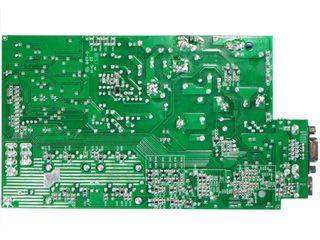
The soldering looks good overall, except for the “blobby” wire solder joints and the fuse solder joints, which show highly inconsistent solder coverage.
Solder Bubbles

Were the solder mask tracks between fuse tabs intended to trap solder and form solid bridges (as they appear to have achieved between the bottom-left two tabs) or only neatly tin the exposed metal, which you see on the top row between the bottom-right tabs? I doubt the bubbles everywhere else were the intended result.
Su’scon All Around

Just like last time, CP used Su’scon capacitors all over the place. Of the electrolytic capacitors I found on this board, the only exception I noticed is a single Taicon HF on the standby/charging supply output. Three 40A fuses in parallel “protect” the #10 (40A) battery cables and feed the four pairs of Chino-Excel Technology CEP83A3 (rated for up to 100A of continuous current at 5.3mΩ RDSon) that make up the full bridge switching ~100A through the inverter’s transformer.
Take it as a reminder that trying to generate 1000VA from a 12V source yields somewhat crazy current figures.
Surge Protection And Other Nearby Bits
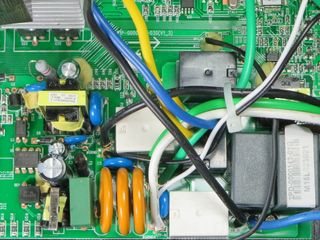
Along the left edge, we have the Viper22 controller and associated components for the charging supply, a bank of three yellow 20D271K MOVs next to a 220nF EMI filter capacitor, four relays handling power routing in the middle and a pair of 2.2µF X2 capacitors smoothing out the inverter’s output.
The UPS was plugged in and splayed out overnight. When I came to take this picture, I noticed that both white relays were a little warm. The same goes for the supply section’s EMI choke. If I had to hazard a guess, I’d say at least 3W are being lost in this component cluster. Let’s see what that translates to in actual measurements.
Standby Power
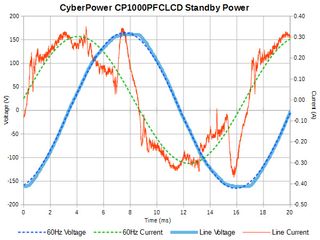
With no load attached, the UPS draws 26.1VA thanks to its output’s relatively large filter capacitor bank, while consuming 6.2W in actual power. That's still not as good as the BE550’s 2.8W, but much better than the SMART1000’s 12W or the LX1500’s 8.8W.
Stay on the Cutting Edge
Join the experts who read Tom's Hardware for the inside track on enthusiast PC tech news — and have for over 25 years. We'll send breaking news and in-depth reviews of CPUs, GPUs, AI, maker hardware and more straight to your inbox.
If you were wondering why the current waveform is so noisy, this is attributable to the X2 caps. They're shunting noise present on the AC feed, which translates into noisy current.
Getting Curious
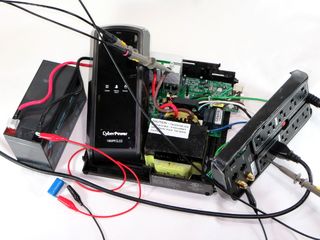
How does the 1000PFCLCD generate its “adaptive sine wave” output and what does it look like? There is only one way to find out: poke around. Here, I am tapped on both sides of the transformer’s low-voltage winding and the inverter output. The little blue capacitor provides AC coupling between the floating inverter circuitry and ground. While not ideal, it's better than blowing something up if there is an operating condition where the low-voltage side may end up connected to line voltage and good enough to find out how the modulation is achieved.
What Does The Scope Say?

There you go, simple as Π: the ‘B’ transformer leg gets switched alternatively between positive and negative battery voltage, while the duty cycle of the 26µs period on the ‘A’ leg gets modulated following a sinusoidal pattern. If you look at the purple trace’s intensity grading, you get a rough idea of how the high/low time varies with output amplitude.
Plugging the oscilloscope’s CSV data output into my analysis spreadsheet under a no-load condition, the output’s THD+N is a reasonable 7.7% while the output voltage is far out in the left field at only 46VRMS. Plug in almost anything, though, and voltage rises to a more reasonable 108V. On the third day of poking around, the low no-load output voltage became intermittent, occurring less than 5% of the time.
Funny Business

Cycling through the LCD’s functions while the 1000PFCLCD is on battery power, with the wacky output voltage showing up on the scope and my multimeter, the UPS still claims that its output is at 120V. It looks like the UPS may be hard-coded to report that figure on battery power instead of actually monitoring its own output voltage.
1000PFCLCD vs SL300
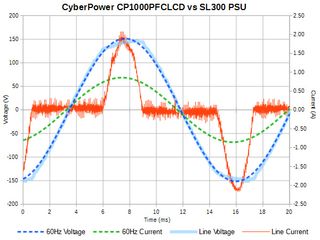
What happens to the output waveform when I plug in my SL300 PSU? The output voltage rises to 108VRMS, THD+N drops to an even better 4.4%, and the built-in display still reports 120V. If this was truly a 120V sinusoidal waveform, it would be peaking at 170V, not 150V. My spreadsheet tells me that the SL300 uses 64.5W and 89.6VA, while the 1000PFCLCD reports 66W and 90VA, which is within my measurement setup’s error margins. Oddly enough, this seems to indicate that the UPS’ power calculation may be based on real output voltage instead of the bogus 120V being displayed. If 120V was hard-coded in the calculation as it appears to be for the display, I would have expected my measurements and the UPS’ to disagree by about 10%.
What Have We Learned Today?

What goes into a $120 “adaptive sine wave” UPS? For the most part, exactly the same stuff that goes into a $50 regular “stepped approximation sine wave” UPS. CyberPower chose to use a full bridge driver with a single low-voltage transformer winding, but it could just as easily have gone with a center-tapped winding and only low-side drivers for each half. In other words: any UPS with fast enough FETs and FET drivers could potentially be converted to sinusoidal output with little more than a firmware upgrade and X2 capacitors on the output.
The overall build and design quality is on par with the LX1500, earning a point for including a #14 cord and then losing it for going cheap on the connectors. The biggest flaws I can find are falsely reporting the output voltage as 120V on battery power and failing to provide an output voltage within 5% of 120V under the same circumstance. Of course, there is also a question mark attached to those Su’scon capacitors, just like there was with the LX.
If you wanted to know the hardware differences between sinusoidal and non-sinusoidal UPSes, now you do: not much.
MORE: APC BE550G Tear-Down
MORE: Tripp-Lite SMART1000LCD Tear-Down
MORE: CyberPower LX1500GU-FC UPS Tear-Down
-
KaiserPhantasma inally =D but will these get a "ok to buy" from you or are there other models/brands we can look at?Reply
also well written nice job on the article -
Daniel Sauvageau Aside from Tripp-Lite which gets a definitive fail for lacking a breaker and wasting twice as much power as almost any other UPS I have taken apart here, they are all "worth looking at" if they suit your specific application.Reply
I'm using the LX1500 for my main PC (not using the coax nor Ethernet protections), I installed the BE550 at my mother's place as planned and I'm currently using the 1000PFCLCD as a portable/isolated AC source.
None of them are perfect but they are all usable. There is that nagging feeling from seeing third or fourth tier caps peppered throughout most of them. Higher quality caps appear to have gone extinct in UPS under ~$160. At least those I have gotten my hands on so far. -
cage0022 I enjoy your reviews, but this was so technical, I'm not even sure if this is a positive review or not. So are you saying it doesn't really do sine wave and if buying for that factor, it's a waste of money?Reply
Lastly, what would you recommend for someone who wants a good sinewave UPS that also offers good surge protection, without breaking the bank? (or, what's the most affordable way to get a good surge protector and battery backup unit?) -
Daniel Sauvageau Reply
It is a tear down, I show you what is inside, comment on some of the things I have seen and readers can decide if what they have seen is worth whatever the unit or an equivalent one might be worth to them. The PFCLCD did produce a (mostly) sinusoidal output but on my unit, the output voltage under no-load condition was intermittently extremely low the first few times I checked. An UPS would not normally run under no-load condition, so that shouldn't be an issue during normal use.18256861 said:I enjoy your reviews, but this was so technical, I'm not even sure if this is a positive review or not.
Where surge protection in UPSes is concerned, none of those I have looked at here so far have anything beyond basic three MOVs surge protection on the power side, the same protection found in the same brands' $10-15 power strips. If you want more thorough power line surge protection, you will need to disregard the UPS and surge protector instructions and use something else with more serious surge protection (isobar, SurgeArrest Performance, SurgeX/Zerosurge, etc.) upstream from the UPS.
-
falchard Actually for a Coax cable you want the dielectric just a bit past the fitting's edge. Depending on how cheap the fitting is, it may need to be a little longer. Still that coax cable is junk and running a coax through the UPS will probably ruin a digital signal. Better to ground out a coax cable at the MPOE instead of through a surge protector.Reply -
cage0022 Reply18258292 said:18256861 said:I enjoy your reviews, but this was so technical, I'm not even sure if this is a positive review or not.
If you want more thorough power line surge protection, you will need to disregard the UPS and surge protector instructions and use something else with more serious surge protection (isobar, SurgeArrest Performance, SurgeX/Zerosurge, etc.) upstream from the UPS.
Thank you for the clarification on the sinewave issue. Where you state, "disregard the UPS and surge protector instructions and use something else with more serious surge protection (isobar, SurgeArrest Performance, SurgeX/Zerosurge, etc.) upstream from the UPS", is that safe to do? I thought I'd read somewhere that you shouldn't plug a UPS into a surge protector (or vise versa). If so, that's what's lead to my quandary - if you shouldn't plug a UPS into a surge protector, then how does when get surge and battery backup?
Also, thank you for the teardowns - although I may not understand the technical side, it's still a great read and good to see someone separating the marketing from the truth.
-
Daniel Sauvageau Reply
Indications against it are stuck on labels, printed or molded into just about every UPS and power strip I have taken apart here. There are two reasons I can think of: not overloading the power bar (which you shouldn't be able to do on a good bar with #14 cord and a 15A breaker in the first place) and poor/intermittent ground connections on those cheap bars or UPS that use simple flaps for the ground connections like the BE550 from last month.18259735 said:is that safe to do? I thought I'd read somewhere that you shouldn't plug a UPS into a surge protector (or vise versa).
Of those two issues, I'd say poor ground is the one that bothers me the most as those square-bent flap-style ground connections are still common despite the more reliable torque contact style (I call them 'torque' because the contact fingers attach to the sides of the metal strips which act as torque bars and reduce strain at bend lines) costing practically the same to manufacture: one slightly more complex cutting die, one slightly more complex bending/shaping die, same amount of metal. (Though based on the level of inconsistency in how flaps get bent, I would not be surprised if they got 'shaped' by poking blunt nails in assembled units instead of a die.)
Every extra cord and junction box between the breaker box and your loads is one more potential point of failure and extra power losses. There is nothing fundamentally wrong with combining devices within reason but manufacturers don't want to take the blame if people exaggerate and something goes wrong.
I believe the only power bar I have seen that lacked such instructions is the SurgeX's SA-1810. That thing is built like a tank, which does not leave much for the company to worry about. I would expect no less from a $200+ surge protector and its instructions even suggest protecting UPSes as one application. -
gamebrigada I would love to see you tear down some "Enterprise" grade UPS's. Some that have some serious reliability and where name brands are paid extra for. I would do one myself out of curiosity but I doubt my opinion would be regarded well.Reply -
jeyman Dan,Reply
I wanted to say that your review is very thorough and well put together. I gained a lot of insight about the Cyberpower units and how they are built (as well as their shortcomings). Thank you for that.
A few things to consider though. Your writing style sometimes comes across as overly sarcastic and you make a presumption that the reader has already gone through your previous articles, leaving off key details or making inferences. Additionally, your readers could benefit from a well formed summary or conclusion as we do not all possess the skill sets that you do. With your attention to detail and obvious subject knowledge, I think your articles could be made even better with a little more time and care.
I look forward to seeing many more of your articles and will make a point to check out your previous postings.
Thanks again for the good read.
Most Popular


